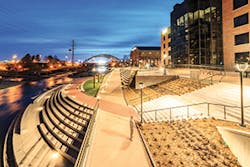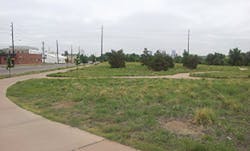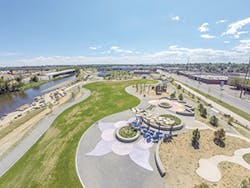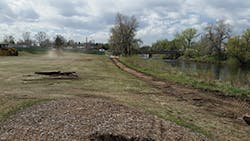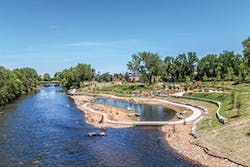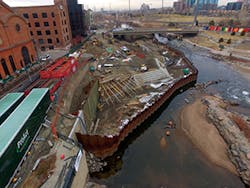River Vision: Denver’s South Platte Communities Transformed
Collaborative construction delivery models such as construction manager/general contractor (CM/GC) with preconstruction services are increasingly proving beneficial to owners and contractors. City and County of Denver’s River Vision is a stunning example of how these methods are providing increased value.
Of the four sites managed by ECI Site Construction, all used the CM/GC delivery method with the exception of the fourth site, which was launched initially as a bid-build project. As we will see, the need for immediate problem-solving at Confluence Park necessitated a higher level of services than is afforded by traditional bid-build delivery. The discovery of site contamination morphed the Confluence Park project into a “hybrid” bid-build project with the addition of preconstruction services. This hybrid took on more of the CM/GC flavor of the first three projects, which enabled the team to provide an amenable solution.
According to ECI President Ted Johnson, ECI has been a vested partner in the Denver community for nearly four decades. “The CM/GC process is truly a testament to one of ECI’s core values—collaboration—which we define in construction as ‘success through teamwork and solving problems together.’ From preconstruction through final acceptance, ECI and our team continually worked together with all project stakeholders to deliver a product that exceeded the client’s objectives. The successful completion of four phases of River Vision is validation of our partnership and goal of delivering a successful project that the entire project team can be proud of,” says Johnson.
Denver’s Liquid Asset: The South Platte River
Beginning with the early Colorado settlers who searched for gold along the South Platte River in 1868 and up until 2007, Denver’s “liquid asset” was a dumping ground. Raw sewage and industrial waste had been spewed into the river for more than a century, turning the South Platte into an open sewer.
In 2007, the City and County of Denver and the Greenway Foundation, headed by Jeff Shoemaker, teamed up with Denver Parks and Recreation and the Urban Drainage and Flood Control District to plan a transformative series of projects that would create vibrant community parks along 10 miles of the river, from Dartmouth Avenue north to 58th Avenue.
Laura Kroeger, program manager for the Urban Drainage and Flood Control District (UDFCD), has championed the GM/GC and collaborative delivery methods, believing they are future “best practices.” Of River Vision, Kroeger says, “The stakeholders knew there would be a limited amount of money to move this vision forward. In order to maximize everyone’s financial contribution, we needed to have a collaborative approach that focused on putting as much money as possible in ‘on-the-ground improvements.’”
The Birth of River Vision
Three years of planning among the passionate group of stakeholders resulted in River Vision, which envisioned urban oases for the communities along the South Platte. Each of the five major projects was designed to tackle four key issues:
- Water quality
- Flood control
- Recreation
- Environmental improvements
River Vision would create vibrant communities in areas that had been unhealthy eyesores. The vision included Johnson-Habitat Park, Pasquinel’s Landing, Grant-Frontier Park, Globeville Landing, and finally Confluence Park, the birthplace of Denver itself.
Four of the River Vision projects were managed by ECI Site Management. ECI had established itself as one of Colorado’s leading site management firms over a period of 38 years, blending urban redevelopment with natural area restoration. “We wanted to stimulate a feeling of pride and belonging for each of the communities we touched,” says Brian Peterson, ECI founder.
ECI’s team, led by senior project manager Ian Mestdagh, was able to deliver the vision to the project owners—the City and County of Denver, UDFCD, and the Greenway Foundation—with the collaboration of strategic partners Earth Services & Abatement and ProAct Services.
Johnson-Habitat Park: From Toxic Waste Site to Environmental Classroom
In 2014, the City and County of Denver selected ECI to implement the vision for Johnson-Habitat Park, located near Denver’s Athmar Park neighborhood. The site was a city dump that contained 100 years’ buildup of asbestos-laden soil. Industrial businesses had been spilling sewage into the river, and the soil and water required complex remediation. As CM/GC, ECI pulled together a team including Pinyon Environmental and Earth Services & Abatement (ESA). ESA has a 20-year history of working with the City and County of Denver and is known for handling complicated remediation projects. ESA removed more than 12,000 cubic yards of asbestos-impacted soil while maintaining compliance with state and local requirements.
“ESA lined, loaded, and wrapped all contaminated soil with two layers of 6-mil poly prior to hauling all of the materials to Denver Arapahoe Disposal Site, which is owned by the City and County of Denver. After ESA completed soil remediation, ECI imported and compacted clean fill and conducted water control and riprap armoring—established during preconstruction—to build a new, fully ADA-compliant concrete jetty for public accessibility down to the water’s edge,” says Kory Mitchell, ESA co-president.
According to ECI’s Mestdagh, best value can be overlooked for sheer price point on some occasions in the bid-build process. “With a bid-build project, soil remediation is usually a lump sum—not a measured item. That would have run the risk of overshooting the cost of the soil or undercutting, which starts a back-and-forth contentious conversation as to who is responsible for the final cost. Because of ECI’s thorough preconstruction services, we were able to assess an accurate price for the soil remediation,” he explains.
“ECI prefers CM/GC over the bid-build model,” says Peterson. “ECI’s preconstruction services, using a collaborative approach among all team members and thoughtful consideration of every possible obstacle before breaking ground, nets a more efficient and value-added process and successful conclusion.”
The $5.2 million project netted a beautiful neighborhood park, an urban outdoor education center, and a campground.
“Projects are complicated today and need a diverse team of experts who can work together,” says Kroeger. “When the team becomes more invested in the project goals than individual goals, you know you have something special, and that is when visions become reality. The public is the biggest winner of the collaborative approach because more time, energy, and resources are directed toward actual improvements—not in unnecessary processes.”
Johnson-Habitat Park now serves as an outdoor environmental classroom and the headquarters for the Greenway Foundation’s SPREE (South Platte River Environmental Education) program. Located on the west side of the river near Alameda Avenue and Jason Street, Johnson-Habitat Park is a premier environmental education and play experience that includes an outdoor classroom, climbing platforms, rock sculptures, sand play, and supervised camping for youth-focused nonprofit programs. It also offers a signature concrete jetty, a stone amphitheater, and a fire pit along the river’s edge. An expanded bike path and soft surface pedestrian trail add to additional enhancements along the South Platte River Trail. Johnson-Habitat Park received the American Public Works Association’s Large Parks and Trails Award for 2015.
Pasquinel’s Landing Gets a Facelift—Featuring a Channel More Akin to the River’s Natural Form
ECI’s second project within River Vision, Pasquinel’s Landing Park, was also launched under the CM/GC delivery method.
“During preconstruction evaluations, we found that there was no environmental cleanup required, so we were able to check that off up front to eliminate that scope of work,” explains Mestdagh. “We were actually in the South Platte River during the 2015 flood with the fourth-highest flows in recorded history. During precon, we assigned a contingency for the water control items, which allowed us to seamlessly fortify water control efforts by utilizing those contingency funds and keep on top of schedule and budget.”
Flood control and bank stabilization were required, as well as much-needed public access to the river. A secondary channel was created to allow access to slow-moving water. Low water crossings now provide a path to a new concrete jetty for fishing and river access. A new ADA-accessible trail and other crusher fine trails with boulder seat walls wind around the turf picnic lawn and river overlook. Many of the existing, mature trees were protected during construction while new landscaping and irrigation were installed, along with native grass areas and an adult fitness area along the South Platte Regional Trail.
Grant Frontier Park Channels River Access—One of the First Places Gold Was Discovered in the Platte Near the City of Denver
Over the last several decades, the Platte River had been channelized in the Grant Frontier Park location, which eliminated public access to the river. As CM/GC, ECI developed a plan to reestablish public access to the river. “During preconstruction, we found that the sacred cornerstone of the park was an expansive, 200-year-old cottonwood tree,” says Mestdagh. “We were able to work with Denver Forestry before commencing the project to assess the requirements of protecting and building the park around this beloved tree.”
Seat boulders, a plaza, and a picnic area now surround the iconic cottonwood. River access was restored by constructing a secondary channel and concrete jetty, separating the main park from a new island.
Mestdagh adds, “This was a massive export project. We worked with the City to utilize some dump sites even before the plan was finalized, in order to save about 50% in export costs during preconstruction. In a bid-build scenario, up to $70,000 could have been added to the bid unnecessarily.”
Today, access to the river and the play areas along the banks are ADA compliant. Historic Montana City, a frontier town educational zone, was expanded and updated, and a new restroom building was added. A new playground, shade structures, walking trails, and retaining walls provide additional areas of play and a new parking lot allows for additional public access.
Confluence Park Presents the Ultimate Challenge—Unexpected Site Contamination Reveals Dire Need for Preconstruction Services
Confluence Park was created after a public-private partnership was formed with the City and County of Denver and the Greenway Foundation to reclaim the South Platte River from a dumping ground to a recreational area. Since the official dedication, the area has continued to grow through several additions, the latest of which includes the visioning of the Confluence Park 2013 Master Plan. This multi-phased master plan included a public recreational area known as Shoemaker Plaza along 15th Street, adjacent to the REI Building in Denver.
The City and County of Denver requested bids on the construction of Shoemaker Plaza in October 2014. Funding sources demanded that the project launch under the bid-build delivery method, and ECI, as low bidder, was awarded the project at $4.2 million.
Discovery of Coal Tar Shuts Down Project for 15 Months. Construction of Shoemaker Plaza began in March 2015. However, just two months in, coal tar was discovered in the soil and the water, which presented a critical issue to be resolved. Coal tar, formed by the distillation of coal, contains polycyclic aromatic hydrocarbons (PAHs). According to EPA, PAHs are known to carry human carcinogens and are toxic to aquatic life.
This contamination issue shut down the project for 15 months, from May to August, and caused the project team to seek out various alternatives to keep this highly publicized project on course. “I was impressed with how well the City of Denver handled the issue,” comments Mestdagh. “Despite this being a high-profile project with a set budget and timeline, Mike Bouchard [assistant director of design and construction at Denver Parks and Recreation] managed the contracting process and public interface, so that the construction team could weigh all the alternatives and not be forced into a rushed decision.”
Overcoming these conditions necessitated value-added processes not customarily delivered under a bid-build format. Thus, preconstruction services were introduced into ECI’s scope in order to facilitate a remediation plan that offered the City and County of Denver several options for rerouting this project that would minimize shutdown time, secure the additional necessary resources, and expedite the construction process.
Dewatering and Coal Tar Removal. According to Mestdagh, ECI held a minimum of one meeting a week among all team members during the entire 15-month shutdown to reassess the ultimate feasibility of the project. Running scenarios from worst case—closing the park and securing the contamination and then reopening the park as a torn-up eyesore—to acquiring funding for the ultimate remediation and additional work required to create a beautiful public recreation area, the team could not help but wonder if the project would come to fruition.
Mestdagh says, “This preconstruction event was massive. There were three major components of the 15-month precon process. First, we had to figure out the extent and overall cost for remediation. Second, we used value engineering of all existing structures to maximize the budget; and third, someone had to go in and find the funding.”
As a critical part of managing the ebb and flow of the Confluence Park project, ECI teamed once again with Earth Services & Abatement. Having developed a relationship with ESA through remediation work at Johnson-Habitat Park, ECI contracted ESA to dewater the site and, once dry, remove the coal tar contamination—taking on the added risk of the environmental impacts of the project.
During preconstruction meetings with the City and County of Denver, the Department of Public Health and Environment (CDPHE), and ECI, ESA determined the need to team with ProAct, specialists in innovative industrial water treatment services.
According to ESA’s Kory Mitchell, ProAct entered the scene in the summer of 2016. ProAct’s water treatment specialist Ehren Koelsch explains that ESA had to drop the water table to install dewatering wells. “As the water was being pulled out, every gallon had to pass through ProAct’s equipment to remove contaminants. Not only was there coal tar, but also heavy metals such as selenium, cadmium, and lead—nasty stuff. We treated 300 gallons of water per minute, 24/7, over a period of six months.”
Mitchell explains, “There is always a concern when we dewater a project with high levels of contamination. We took a conservative approach at Confluence Park with three of ProAct’s water treatment trailers onsite at one point, running an elaborate dewatering and contamination removal system. Discharging water is a very sensitive issue because nobody wants to take on the responsibility of possibly discharging contaminants back into the river, which is why it was imperative that we put together a top-notch team.
“Our initial treatment was to pump the water into ProAct’s weir tanks, where some of the solids settled out of the water, and then pump the water through a system of bag filters. From that system, it was pumped into 20,000 pounds of carbon. Next, the water was treated with activated alumina and resin. At that point, we used a third-party testing firm to ensure that all of the contaminants were treated to below the regulated limits each week. All in all, we treated 64 million gallons of water and never had a regulatory exceedance.”
Once the site was dry enough to dig, ESA performed coal tar excavation, which was hauled offsite to a landfill. ECI was then able to perform excavation to set the foundation for the terraced structure, which would be built by Terra Site Constructors. ESA had to continuously keep the water out of the area during the excavation while the water was simultaneously being treated. Koelsch adds, “It was really exciting to see the project unfold through day and night, as we were front and center in downtown Denver. People were going in and out of REI and sipping lattes at Starbucks, watching all of it happen.”
Time-and Money-Saving Measures. The Confluence Park project progressed with ECI, ESA, ProAct, LT Environmental, and Terra Site Constructors working alongside each other, implementing several ways to help save time and money on the project. “Due to the tiny footprint of the project and the additional contamination issue, the team worked in double shifts,” says Mestdagh. “This 24-hour operation included moving soil at night to create space to work the next day, all while having excavators and the dewatering system running during the day to keep the project moving forward.”
The use of sheet walls versus concrete walls alongside the river helped minimize the amount of soil that needed to be moved and thus saved the construction team time and labor costs. The use of precast concrete for the terracing, which only took about seven days, saved approximately five additional weeks that would have been required to employ the more traditional cast-in-place method.
Nature’s Challenges. The construction team also had to overcome some extreme weather issues. With the project recommencing in September 2016, the team performed extensive concrete work during winter, the most challenging time of year. ESA took precautions to heat-wrap all of the piping in the entire system to prevent pipe freezes.
In addition to outdoor temperatures, water flows presented an environmental issue that impacted the project. According to Mestdagh, the river experienced some of its highest water flows in 2015. While the average water flow in the South Platte is between 500 and 800 cubic feet per second (cfs), during this project, the water flow tapped out at 3,500 cfs for 3.5 months and was as high as 16,000 cfs during a huge thunderstorm.
The final water flow challenge for the project was caused by a water main break on January 28, 2017, in the Highlands by Denver Water. The main break completely flooded the project site when a 2-foot-wide water main broke at West 29th Avenue and Zuni Street. ESA was able to respond immediately and had the site cleaned out in one day, says Mitchell.
Fruition of the Vision. The Confluence Park project presented serious challenges and unforeseen issues that forced the project into preconstruction efforts by ECI and its team. Under the new hybrid delivery method, ECI assumed its preferred role as CM/GC and led the team through a thorough assessment of the issues they were facing to completion. “It was the thoughtful collaborative effort we achieved during preconstruction that made this stymied project a success,” says Mestdagh. By the fall of 2017, Confluence Park was completely transformed into a bustling recreational area that represents the next generation of Denver’s parks.
See the River Vision video on Stormwater’s website or at this link: www.youtube.com/watch?v=540jCfkPK-M&feature=youtu.be.
Glossary of Construction Delivery and Planning Terms
Preconstruction Services: Not a delivery model, preconstruction services are increasingly offered within collaborative delivery models such as CM/GC and design-build. ECI offers extensive preconstruction planning services that go well beyond just estimating in order to refine the entire process to reduce risk and deliver a successful project more efficiently, with added value. The CM/GC performs preliminary planning and value engineering in order to define the project, identify potential issues, and analyze cost impacts. They team with subcontractors and define the project scope, schedule, and cost as early as possible with the most efficient use of resources. These services help the owner determine the viability of the project. When viability is confirmed, a firm cost and schedule are determined.
Traditional Delivery Model:
Bid-build: This method usually starts with the owner selecting and entering into a contract with an architect or other design professional. The architect fully develops the design and creates “bid documents” that are then made available to general contractors for competitive bids. The bid process can either be an open bid or by invitation. Once a suitable contractor is selected, the owner and contractor execute a separate contract to build. The contractor, in turn, engages subcontractors and suppliers to perform the work. The design-bid-build approach is best when the owner wishes to be actively involved in the design process, requires a fixed cost before the commencement of construction, and has sufficient time to permit the design to be fully completed before construction bids are obtained. This method is often used for very large, complex projects. Since the design is fully developed, an “apples-to-apples” comparison of multiple bids can be made.
Collaborative Delivery Models:
Construction manager/general contractor (CM/GC), also known as construction management at risk (CMAR): With CM/GC delivery, constant collaboration throughout the entire project is key. The CM/GC serves as the construction manager, collaborating with the owner and all contractors throughout the entire project. This delivery model is increasingly preferred because the GC is brought on at the earliest stages of the project. They suggest updates to the design that can positively impact project costs, scheduling, materials, and efficiency. In Phase 1 – Design and Preconstruction Services, the CM/GC works with the designer and the project owner to identify risks, provide cost projections, and refine the project schedule. The CM/GC then negotiates with the project owner on the price for the construction contract. If all parties are in agreement with costs, then Phase 2 – Construction begins. Finally, the project is delivered under a GMP (guaranteed max price) and schedule, reducing owner risk.
Design-Build: Design-build delivery streamlines project delivery because of a single entity—a team of designers and the contractor—working together via a single contract with the owner. One entity drives a unified flow of design and construction from initial concept through completion. Change orders and disputes are rare because coordination of project elements is placed squarely upon the shoulders of the design-build team.
The Players
- Project Owners: City and County of Denver with Urban Drainage and Flood Control District and The Greenway Foundation
- Construction Manager/General Contractor: ECI Site Construction
- Site Dewatering and Remediation: Earth Services & Abatement
- Water Treatment: ProAct Services Corporation
- Structural Concrete: Terra Site Constructors
- Environmental Engineers: LT Environmental
ECI Site Construction Management: ECI leverages extensive design and construction expertise to develop project definition, scope, cost, and schedule at the earliest phases of a project. Using preconstruction strategies, ECI can guarantee a cost and schedule for a project. Their comprehensive preconstruction services assist clients with project scope development, constructability reviews, value engineering, and preparation of construction costs. All of ECI’s construction cost estimates are prepared in-house by professional estimators, and these estimates are supplemented with pricing from either their subcontractor base or project specific, pre-qualified subcontractors.
Earth Services & Abatement: ESA has been a leader in the environmental and demolition industries since 1982. For 11 years running, ESA ranked in the top 20 firms in asbestos abatement in the US by Engineering News Record and in 2017 was ranked in the top 10.
ProAct Services Corporation: With an emphasis in onsite industrial water treatment, industrial air treatment, industrial degassing/vapor control, environmental remediation, and suspended solids removal, ProAct Services Corporation is committed to delivering exceptional service in a safe, responsive manner to ensure client satisfaction.
